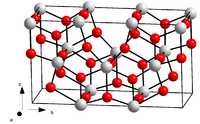- Tantalum pentoxide
-
Tantalum pentoxide 
Identifiers CAS number 1314-61-0 
Properties Molecular formula Ta2O5 Molar mass 441.893 g/mol Appearance white, odorless powder Density 8.20 g/cm3 [1] Melting point 1872 °C
Solubility in water insoluble Solubility insoluble in ethanol, most acid
soluble in hot conc.HF pentoxide (verify) (what is:
pentoxide (verify) (what is:  /
/ ?)
?)
Except where noted otherwise, data are given for materials in their standard state (at 25 °C, 100 kPa)Infobox references Tantalum pentoxide is Ta2O5, also known as tantalum(V) oxide. Both orthorhombic and hexagonal phases are known. Ta2O5 is a high refractive index, low absorption material useful for coatings in the near-UV to IR spectra regions; it decomposes only at temperatures >1470 °C.
Contents
History
The metal oxide discovered by Anders Gustaf Ekeberg was obtained from minerals taken from pegmatite (an igneous rock associated with tantalite or columbite) at Ytterby, Sweden, and Kimoto, Finland. The microlite-pyrochlore mineral series is also a source of tantalum oxide. Microlite contains approximately 70% of tantalum oxide, and pyrochlore contains approximately 10%.
Synthesis
There are several methods available for the synthesis of tantalum oxide. One method involves isolating tantalum pentoxide by crushing a concentrate of the mineral columbite-tantalite and fusing the powdered mineral with sodium hydroxide to give a slurry of mixed insoluble niobic and tantalic acids. The mixed acids are dissolved by passing anhydrous hydrofluoric acid into the slurry and adding the stoichiometric quantity of potassium fluoride to yield a salt. The salts can be separated by a liquid-liquid extraction process, using various ketones as the liquids.
- (FeMn)(NbTa)2O6 + 6NaOH → Ta2O5·7H2O + Nb2O5·7H2O
- ½Ta2O5·7H2O + ½Nb2O5·7H2O + 16KF → K2TaF7 + K2NbF7 + 2HF + 12KOH
Or,
- ½Ta2O5 + ½Nb2O5 + 4KF + 10HF → K2TaF7 + K2NbF7 + 5H2O
Once K2TaF7 has been isolated, Ta can be extracted by the electrolysis of molten K2TaF7. This pure form of tantalum is then exposed to oxygen at temperatures above 1000 degrees Celsius, to form Ta2O5.
It can also be synthesized by hydrolysis of its alkoxide:
-
- 2 Ta(OCH2CH3)5 + 5 H2O → Ta2O5 + 10 HOCH2CH3
Use
Ta2O5 is used to make capacitors in automotive electronics, cell phones, and pagers, electronic circuitry; thin-film components; and high-speed tools. In the 1990s, there was a very strong interest to do research on tantalum oxide as a high-k dielectric for DRAM capacitor applications. For example, Elpida Memory (a Japanese company making DRAM) has put in a strong effort to improve ultrathin tantalum oxide films for DRAM applications. Subsequently in the 2000s, this strong interest has dropped very significantly. It is being used in on-chip MIM capacitors for RF CMOS integrated circuits. Due to its high index of refraction, Ta2O5 has been utilized in the fabrication of the glass of many photographic lenses.
Reactions
Ta2O5 can be chlorinated to become TaCl5 by heating a mixture of tantalum pentoxide and carbon tetrachloride in a sealed glass tube in a high pressure steel reaction vessel.
- Ta2O5 + 5CCl4 → 2TaCl5 + 5COCl2
Ta2O5 can be reduced several different ways, including the use of metallic reductants such as calcium and aluminum.
- Ta2O5 + 2Al → Al2O3 + TaO2 + Ta
- Ta2O5 + Ca → CaO + TaO4 + Ta
These reactions can be further modified to yield pure tantalum via stoichiometry, thermal control and electrolysis.
Materials to avoid when dealing with tantalum pentoxide are strong oxidizing agents, chlorine trifluoride, bromine monofluoride, lithium and acids.
Structure
Both low and high temperature forms exist. The low temperature form is known as β-Ta2O5, and the high temperature form is known as α-Ta2O5. The transition point between these two forms has been reported as 1360 °C. The transition is slow but reversible. The structures of both forms consist of chains built from octahedral and pentagonal bipyramidal polyhedra sharing opposite vertices. These chains are further joined by sharing edges to yield the 3D structure.
References
Further reading
- "Tantalum compounds: ditantalum pentoxide". WebElements: the periodic table on the web. WebElements. http://www.webelements.com/compounds/tantalum/ditantalum_pentaoxide.html. Retrieved 18 November 2011.
- Fairbrother, Frederick (1967). The Chemistry of Niobium and Tantalum. New York: Elsevier Publishing Company. pp. 1-28. ISBN 9780444402059.
- Wells, A.F. (1947). Structural Inorganic Chemistry. Oxford: Clarendon Press.
Tantalum compounds Categories:- Tantalum compounds
- Oxides
Wikimedia Foundation. 2010.
